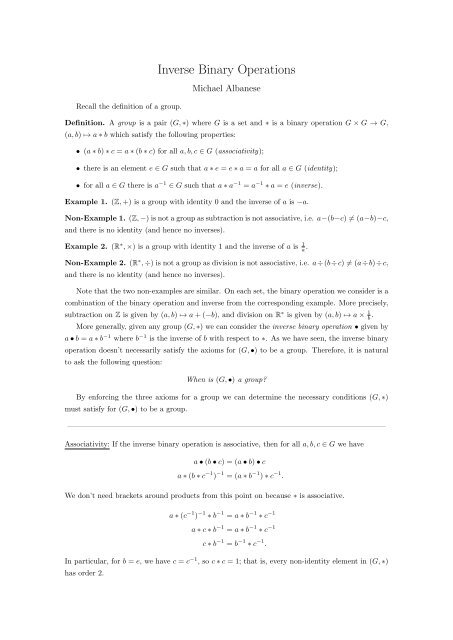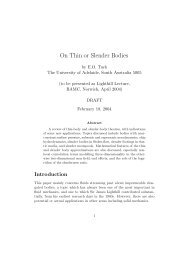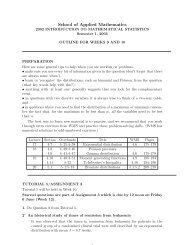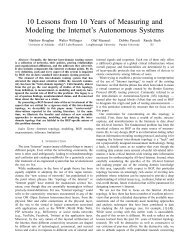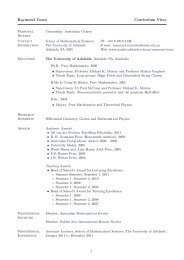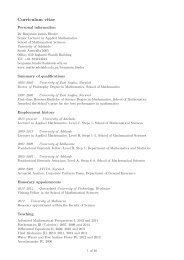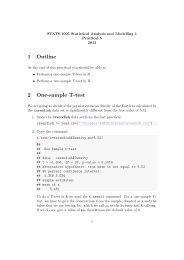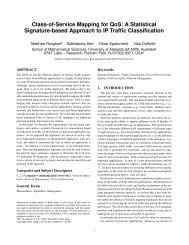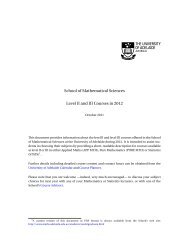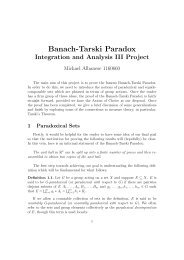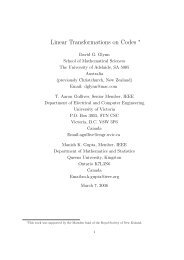Inverse Binary Operations
Inverse Binary Operations
Inverse Binary Operations
You also want an ePaper? Increase the reach of your titles
YUMPU automatically turns print PDFs into web optimized ePapers that Google loves.
<strong>Inverse</strong> <strong>Binary</strong> <strong>Operations</strong>Michael AlbaneseRecall the definition of a group.Definition. A group is a pair (G, ∗) where G is a set and ∗ is a binary operation G × G → G,(a, b) ↦→ a ∗ b which satisfy the following properties:• (a ∗ b) ∗ c = a ∗ (b ∗ c) for all a, b, c ∈ G (associativity);• there is an element e ∈ G such that a ∗ e = e ∗ a = a for all a ∈ G (identity);• for all a ∈ G there is a −1 ∈ G such that a ∗ a −1 = a −1 ∗ a = e (inverse).Example 1. (Z, +) is a group with identity 0 and the inverse of a is −a.Non-Example 1. (Z, −) is not a group as subtraction is not associative, i.e. a−(b−c) ≠ (a−b)−c,and there is no identity (and hence no inverses).Example 2. (R ∗ , ×) is a group with identity 1 and the inverse of a is 1 a .Non-Example 2. (R ∗ , ÷) is not a group as division is not associative, i.e. a÷(b÷c) ≠ (a÷b)÷c,and there is no identity (and hence no inverses).Note that the two non-examples are similar. On each set, the binary operation we consider is acombination of the binary operation and inverse from the corresponding example. More precisely,subtraction on Z is given by (a, b) ↦→ a + (−b), and division on R ∗ is given by (a, b) ↦→ a × 1 b .More generally, given any group (G, ∗) we can consider the inverse binary operation • given bya • b = a ∗ b −1 where b −1 is the inverse of b with respect to ∗. As we have seen, the inverse binaryoperation doesn’t necessarily satisfy the axioms for (G, •) to be a group. Therefore, it is naturalto ask the following question:When is (G, •) a group?By enforcing the three axioms for a group we can determine the necessary conditions (G, ∗)must satisfy for (G, •) to be a group.——————————————————————————————————————————Associativity: If the inverse binary operation is associative, then for all a, b, c ∈ G we havea • (b • c) = (a • b) • ca ∗ (b ∗ c −1 ) −1 = (a ∗ b −1 ) ∗ c −1 .We don’t need brackets around products from this point on because ∗ is associative.a ∗ (c −1 ) −1 ∗ b −1 = a ∗ b −1 ∗ c −1a ∗ c ∗ b −1 = a ∗ b −1 ∗ c −1c ∗ b −1 = b −1 ∗ c −1 .In particular, for b = e, we have c = c −1 , so c ∗ c = 1; that is, every non-identity element in (G, ∗)has order 2.
——————————————————————————————————————————Identity: Let e ∈ G be the identity element of (G, •). Then, for any a ∈ G we havee • a = ae ∗ a −1 = ae ∗ a = a,where we have used the fact that every element in (G, ∗) is its own inverse. As e ∗ a = a musthold for all a ∈ G, e must also be the identity element of (G, ∗). Note that the other condition(a • e = a) is now automatically satisfied.——————————————————————————————————————————<strong>Inverse</strong>: Fix a ∈ G. Let b ∈ G be the inverse of a with respect to •. Then we havea • b = ea ∗ b −1 = ea ∗ b = e,where we have used the fact that every element in (G, ∗) is its own inverse. By the uniquenessof inverses in (G, ∗) we must have b = a −1 . Note that the other condition (b • a = e) is nowautomatically satisfied.——————————————————————————————————————————So, the necessary condition for (G, •) to be a group is that every non-identity element of G hasorder two with respect to ∗ (we did not need to impose any further assumptions to guarantee theexistence of an identity and inverses). Not only is this condition necessary, it is also sufficient (thethree axioms are satisfied by construction).If (G, ∗) is a group such that every non-identity element has order 2, then (G, •) is a group.The identity element with respect to • is the identity element with respect to ∗, and the inverseof a with respect to • is the inverse of a with respect to ∗. Given that these two groups have thesame identity and inverses, are they really different groups? No! Note thata • b = a ∗ b −1 = a ∗ b,where we have used the fact that each element is its own inverse. Therefore • = ∗; that is, (G, ∗)and (G, •) are equal as groups – not just isomorphic, actually equal! It is worth noting that thisrealisation could have been made after enforcing associativity alone, in which case the fact thatthe two groups have the same identity and inverses would be obvious.


